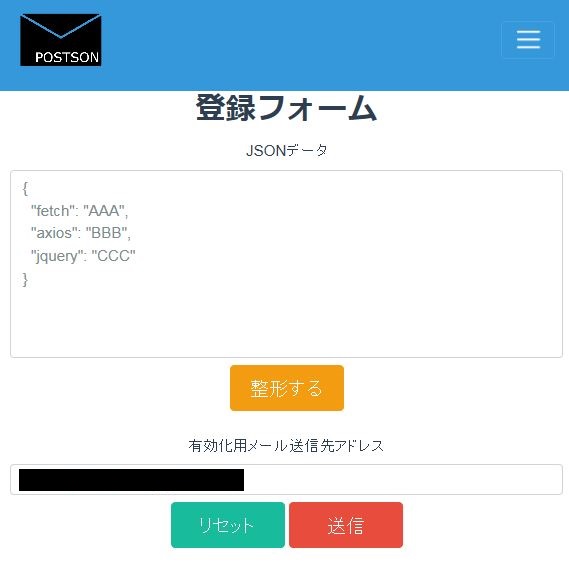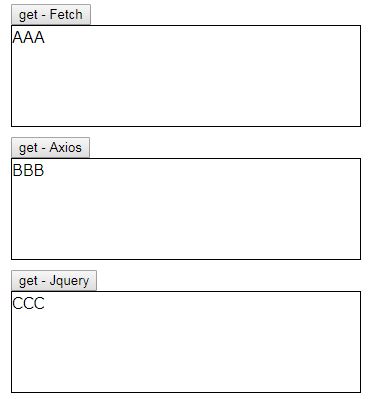先日のWeb サービスを作ってみました。で、
「jQuery 以外の Ajax 処理用ライブラリとそれを利用した実装」 をやると書いたので、
せっかくだから自分でPOSTSONに投稿して、アクセスしてみます。
目次
というか Ajax 処理用ライブラリなんてない・・・。
「Ajax」と調べると、
Ajax(エイジャックス、アジャックス)は、ウェブブラウザ内で非同期通信を行いながらインターフェイスの構築を行うプログラミング手法である。XMLHttpRequest(HTTP 通信を行うための JavaScript 組み込みクラス)による非同期通信を利用し、通信結果に応じてダイナミック HTML (DHTML) で動的にページの一部を書き換えるというアプローチを取る。
Wikipedia より
ということは、Ajax 用のライブラリなんてなくて、
- http のクライアントで、
- 非同期通信し、
- ページを動的に書き換える
以上をしていれば、何を使ってようと Ajax だ。
ということで、http クライアントを試すことにする。
今回は、fetchAPI、axios、それと jQuery。これは比較対象としての意味合いだけど。
データの登録
とりあえず、Ajax でデータアクセスする対象を作ります。
POSTSONでデータの保存をしてみます。
こんな感じ

登録するデータは以下の通りとします。
1
2
3
4
5
| {
"fetch": "AAA",
"axios": "BBB",
"jquery": "CCC"
}
|
登録したらメールが飛んでくるので、
アクティベーションしデータ配信用の URL を取得します。
データ取得
axios と jQuery はパッケージのダウンロードをしておきます。
npm i axios jquery --save
index.html として以下を作成しました。
index.html1
2
3
4
5
6
7
8
9
10
11
12
13
14
15
16
17
18
19
20
21
22
23
24
25
26
27
28
29
30
31
32
33
34
35
36
37
38
39
40
41
42
43
44
45
46
47
48
49
50
51
52
53
54
55
56
57
58
59
60
61
62
63
64
65
66
67
68
69
70
71
72
73
74
75
76
77
78
79
80
81
82
83
84
85
86
87
88
89
90
91
92
| <html>
<head>
<script src=".\node_modules\axios\dist\axios.min.js"></script>
<script src=".\node_modules\jquery\dist\jquery.min.js"></script>
<script>
var url = "[データソースにするURL]";
function getdataFetch() {
fetch(url, {
mode: "cors",
})
.then(function (response) {
return response.json();
})
.then(function (body) {
console.log(body.fetch);
document.getElementById("resultFetch").innerText += body.fetch;
})
.catch(function (error) {
console.log(error);
document.getElementById("resultFetch").innerText = "ERR";
});
}
function getdataAxios() {
axios
.get(url)
.then(function (response) {
return response.data;
})
.then(function (body) {
console.log(body.axios);
document.getElementById("resultAxios").innerText += body.axios;
})
.catch(function (error) {
console.log(error);
document.getElementById("resultAxios").innerText = "ERR";
});
}
function getdataJquery() {
$.ajax({
url: url,
})
.done(function (responce) {
console.log(responce.jquery);
document.getElementById("resultJquery").innerText +=
responce.jquery;
})
.fail(function (XHR, status, error) {
console.log(error);
document.getElementById("resultJquery").innerText = "ERR";
});
}
</script>
<style>
.api {
margin: 10px;
}
.result {
height: 100px;
border: black 1px solid;
}
</style>
</head>
<body>
<section class="api">
<div>
<button onclick="getdataFetch()">get - Fetch</button>
</div>
<div class="result" id="resultFetch"></div>
</section>
<section class="api">
<div>
<button onclick="getdataAxios()">get - Axios</button>
</div>
<div class="result" id="resultAxios"></div>
</section>
<section class="api">
<div>
<button onclick="getdataJquery()">get - Jquery</button>
</div>
<div class="result" id="resultJquery"></div>
</section>
</body>
</html>
|
index.html を表示するして、それぞれボタンを押すと次のようになる。

ちなみに、このままだと IE11 は fetchAPI も axios も動かない。
fetch は、promise も使用するようで、fetch と promise のそれぞれの polyfill が必要だった。
なので head 要素に以下を追加する。
1
2
| <script src="https://www.promisejs.org/polyfills/promise-6.1.0.min.js"></script>
<script src="https://cdnjs.cloudflare.com/ajax/libs/fetch/1.0.0/fetch.min.js"></script>
|
axios だけなら、
1
| <script src="https://www.promisejs.org/polyfills/promise-6.1.0.min.js"></script>
|
だけでよかった。
fetchAPI と axios の使ってみて
今回 fetchAPI と axios を使ってみた。
この記事上は post は試してないわけだけど、fetchAPI と axios の違いはほとんどない
エラーコントロールの観点で、fetchAPI = axios > jQuery かなって感じ。
then と catch が使えるのは、やっぱり便利だなと。
次使うときは、IE11 をサポートしないなら fetchAPI、
サポートするなら、axios を使う気がする。
ではでは。

